We survived the 500th anniversary of the death of Leonardo da Vinci (1519-2019), the unfortunate 500th anniversary of Raphael‘s death (1520-2020) and the 600th anniversary of the beginning of the works for the Brunelleschi‘s dome (1420-2020). Will we be able to overcome even the 700th anniversary of the death of Dante Alighieri (1321-2021)?!
One thing is certain: never before has our generation found itself lost in the darkness of the “selva oscura” (dark forest).
Let’s see if the light of culture will make us re-emerge from the darkness. On the other hand, weren’t you made to follow “virtute e canoscenza” (virtue and knowledge) ?!
So let’s begin our cultural pilgrimage to celebrate the 700th anniversary of the death of Dante Alighieri, father of the Italian language, author of the Divine Comedy, sweet nightmare for students, perennial mixed of blessing and curse for writers, point of reference for the whole Italian civilization.
In this article, a synthetic biographical compendium of Dante without adding – perhaps – nothing new to the rivers of ink spent over the centuries, a bespoke itinerary in Dante’s places in Florence, and a complete list of all events and initiatives – online and , hopefully, in person! – in 2021.
Happy reading … or, better, happy journey!
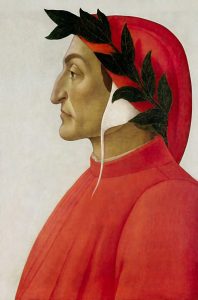
Dante 700: Dante’s identikit
Name and surname: called Dante by everyone, his Christian name was actually Durante Alighieri (you didn’t know, right?!).
Birthplace: …“sovra ‘l bel fiume d’Arno a la gran Villa”, in Florence, in the sesto of San Pier Maggiore. It corresponds to the parish of San Martino al Vescovo, in front of the Torre della Castagna. The location is certain thanks to the presence of a document about a dispute between the prior of San Martino al Vescovo and the Alighieri, due to the roots of a fig tree, which, from the ground of Dante’s house, ruined the fence of the church garden…
Birthdate: between the end of May and the beginning of June in 1265, probably on May 29th, 1265.
Starsign: Gemini.
Christening date: on March 26th, 1266, in the Baptistery of St John, in Florence, later dubbed by Dante “my fair San Giovanni”.
Family: his ancestors were Cacciaguida and Alighiera, of Emilian origin. Alighiera gave the name to the entire family. Dante’s parents were called Alighiero II and Bella degli Abati. Unfortunately, his mother Bella died in 1273; his father later remarried with Lapa di Chiarissimo Cialuffi. Dante had a brother, Francesco, and a sister, Gaetana known as “Tana”, both children of their father’s second marriage. Dante’s family belonged to the minor nobility, of Guelph tradition, and had origins dating back to the 11th century.
Education: Dante studied the “trivio” (grammar, rhetoric, dialectics) and the “quadrivio” (arithmetic, music, astronomy, mathematics). He attended the intellectual master Brunetto Latini and philosophical studies at the Franciscan convent of Santa Croce and the Dominican convent of Santa Maria Novella, a combination of humility and wisdom. Dante studied Aristotle, Boethius, Eratosthenes of Cyrene, probably also read Lucretius‘s “De rerum natura”. Of multifaceted interests, he nevertheless concentrated on politics and literature.
Marital status: married to Gemma Donati. Dante married Gemma in 1285. During his exile, the Supreme Poet left his wife in Florence…
The love of life: Beatrice Portinari. Daughter of Folco Portinari, founder of the Hospital of Santa Maria Nova in 1286, she married Simone de Bardi, to whom she gave six daughters. She died very young in 1290, causing Dante to plunge into despair. Dante met Beatrice for the first time in 1274: she was only nine years old!
Sons: Jacopo, Pietro, Giovanni and Antonia (she took her vows as a nun, choosing the name of Beatrice). Dante’s current heirs in Verona are the counts Serego Alighieri, producers of Amarone wine.
Profession: man of letters and politician. In 1289 he fought in the role of “feditore” at the Battle of Campaldino between Guelph Florence and Ghibelline Arezzo, winning a sensational victory. From 1295, he was a registered member of the Guild of Doctors and Apothecaries. In 1300, he was one of the priors elected by the Florentine Republic to exercise executive power. In 1302, he was sentenced to exile, with the death sentence if he were found on Florentine soil. Years later, he received the proposal for a truce granted to the White Guelphs by Florence. By paying a fine, the return was in fact granted: Dante refused.
Political orientation: White Guelph, moderate party. The division between White Guelphs and Black Guelphs took place in Florence on May 1st, 1300 between the Donati and the Cerchi. The Black Guelphs won and obtained the support of the King of France Philip the Fair and Charles of Valois, supporters of the Pope.
Worst enemy: Pope Bonifacio VIII, called “the soverign Pope”. In 1300, he proclaimed the first Jubilee in history. He issued the “unam sanctam” bubble which reaffirmed the superiority of spiritual power over temporal power.
Works: Vita Nuova (1293-94), Le Rime (1294), Convivio (1304-08), De Vulgari Eloquentia (1303-1305), Monarchia (1312), Divina Commedia (1304-1321 circa).
Travels: Dante was sentecend to exile in 1302. From 1302, he traveled to various locations: Verona (he was a guest at Cangrande della Scala), Treviso (guest at the Da Camino family), Padua, Venice, Lucca, Casentino (guest at the Guidi counts), Lunigiana (guest at the Malaspina family), Ravenna (guest at Guido da Polenta). A trip to Paris is possible.
Particular signs: genius, unifier of the Italian language, big nose and endowed with unshakeable Florentine pride.
Death: the night between 13th and 14th September, in Ravenna.
Burial place: Basilica of St Francis, Ravenna. Originally, the tomb was commissioned by Guido Novello da Polenta, lord of Ravenna; it was then embellished in 1483 by the marble bas-relief with the portrait of Dante, executed by Pietro Lombardo. The current Neoclassical style mausoleum is the work of Camillo Morigia and dates back to 1782.
Curiosity: On 25 March 2020, the Dantedì (Dante’s Day) was established, considered the day of departure of Dante’s journey in the Divine Comedy.
Dante 700: 7 unmissable Dante’s places in Florence
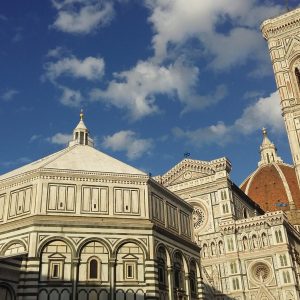
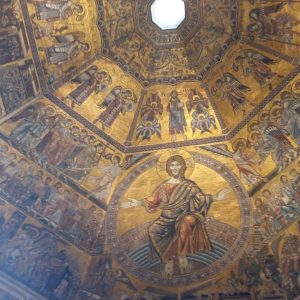
1. Baptistery of St John: on March 26th, 1266, Dante was baptized in the Baptistery of San Giovanni. Built in the 9th century over the remains of a Roman domus, it was dedicated to St John Baptist, patron saint of Florence. Built in Florentine Romanesque style between 1000 and 1300 with the typical marble inlay cladding in white Carrara marble and green serpentine from Prato, it is a masterpiece of Florentine architecture. The Baptistery was under the patronage of the Calimala Guild, the oldest guild of the seven major arts, founded in 1182. The coat of arms of the Arte di Calimala, the eagle that claws the core of twelve cloths, is visible everywhere on the Baptistery. Famous for the bronze doors cast by Andrea Pisano and Lorenzo Ghiberti, it houses inside a glowing firmament of mosaics signed by Coppo di Marcovaldo, Meliore di Jacopo, the Maestro della Maddalena and perhaps Giotto It was the representation of Coppo di Marcovaldo’s Hell that inspired Dante’s Inferno.
2. Casa-Museo Dante: the project for the construction of a museum dedicated to Dante Alighieri came to life in 1865, when Florence became the capital of Italy and the 600th anniversary of Dante’s birth was celebrated. Nevertheless, the museum was set up only in the twentieth century by Giuseppe Castellucci in a corner of the medieval city, corresponding to the tower house of the Giuochi family. Inaugurated in 1965, the house-museum, therefore, is not the real birthplace of Dante, but an educational museum that illustrates the life, works and thought of Dante Alighieri.
3. Santa Margherita de’ Cerchi Church: it is the church where Dante and Beatrice met for the first time, at the age of nine. Beatrice was accompanied by her mother, Cecilia de ‘Caponsacchi, and by her nurse, Monna Tessa. The humble church was under the patronage of the Portinari, Cerchi, Ricci and Giuochi families. Here lie the remains of Beatrice and Monna Tessa.
4. National Museum of Bargello: it is the first national museum of Florence and Italy, inaugurated in 1865 thanks to … Dante! Indeed, on 21 July 1840, in the Chapel of the Magdalene, the first portrait of Dante Alighieri, painted by Giotto, came to light. The Bargello, which was used as a prison until 1857, was therefore restored and inaugurated as a museum of sculpture and decorative arts in 1865, following the model of the Victoria & Albert Museum in London and the Musée de Cluny in Paris. There are other portraits of Dante in Florence… can you guess where ?!
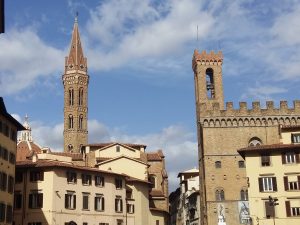
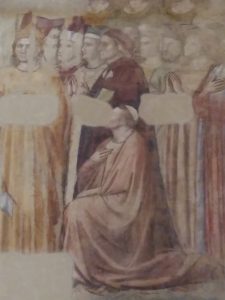
5. Sasso di Dante: between Via dello Studio and Piazza delle Pallottole, there is a stone indicated as “Dante’s stone“. According to tradition, in this place Dante loved to sit and reflect, write and concentrate, absorbed in his own meditations, while admiring the upcoming works for the Duomo.
6. Dante’s Plaques: Dante’s plaques in Florence are 34 in all (9 for Hell, 5 for Purgatory, 20 for Paradise). They were conceived in the twentieth century by Isidoro del Lungo and placed in direct relationship with the city.
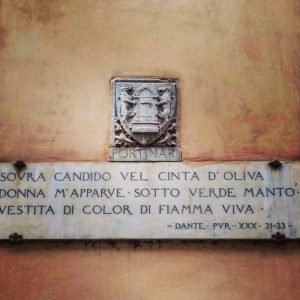
7. Piazza Santa Croce and Basilica of Santa Croce: everyone knows that Dante’s tomb is located in Ravenna, but the Florentines did everything to pay homage to Dante’s absent body. In 1865, in fact, Enrico Pazzi sculpted the statute of Dante, which was initially located in the center of Piazza Santa Croce. After the tragic flood of 4th November 1966, which, we recall, mainly upset the district of Santa Croce, the lowest in the city, the statue was moved to the side of the façade. As for the Basilica of Santa Croce, however, in 1830 Stefano Ricci was commissioned to pay homage to Dante with a cenotaph, flanked by the allegories of Italy and Poetry. Too bad that the result makes one think of a Dante who is a bit too fit. Certainly not Ricci’s most successful work … but if you are a Dante fan, why miss it?
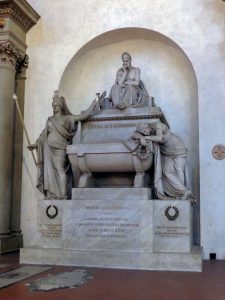
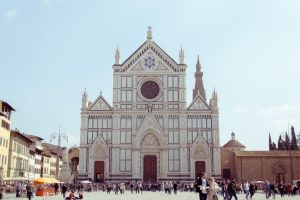
NB: Dante’s places in Florence certainly do not end here… rather! To visit them all, why not book a guided tour with My Flora Guide?
Dante 700: the temporary exhibitions in Florence in 2021
Here is a list of the virtual and flesh-and-blood exhibitions on Dante Alighieri that are scheduled in Florence in 2021. It is highly recommended to check every single event, because the initiatives are updated very quickly, based on the health emergency situation. For some exhibitions, information about the start date is not yet available. We therefore invite you … to be patient, and to stay connected with My Flora Guide!
Also of note is the upcoming opening project of the Museum of the Italian Language, at the museum complex of Santa Maria Novella and the path “Le Vie di Dante“, which won the “Best in Travel 2021 – Sustainability” award from Lonely Planet.
- “To rebehold the stars”. Dante Illustrated: a tribute for the 700 years since the Master Poet’s death
https://www.uffizi.it/en/online-exhibitions-series/to-rebehold-the-stars
- “Non per foco ma per divin’arte”. Dantean echoes from the Uffizi Gallery
https://www.uffizi.it/en/online-exhibitions/dante
- “Dante 700. Santa Maria Novella”. Un ritratto di Dante e i luoghi del poeta nelle fotografie di Massimo Sestini (from 29 October 2020 till 31 March 2021)
http://musefirenze.it/en/mostre/dante-700-santa-maria-novella/
- “Onorevole e antico cittadino di Firenze. Il Bargello per Dante”. Museo Nazionale del Bargello (from 23 March 2021 till 25 July 2021)
https://www.bargellomusei.beniculturali.it/musei/1/bargello/
- “La mirabile visione. Dante e la Commedia nell’immaginario simbolista”. Museo Nazionale del Bargello (from 23 September 2021 till 9 January 2022)
https://www.bargellomusei.beniculturali.it/musei/1/bargello/
- “Dall’Inferno all’Empireo – Il mondo di Dante tra scienza e poesia”. Museo Galileo and Uffizi Gallery.
- “Nel nome di Dante”. Palazzo Strozzi. (Promoted by Associazione degli Italianisti – in collaboration with Società Dantesca, Società Dante Alighieri and Società italiana viaggiatori – temporary exhibition of the British artist Tom Phillips).
- “Dante e il suo tempo nelle biblioteche fiorentine”. Biblioteca Mediceo-Laurenziana, Biblioteca Riccardiana e Biblioteca Nazionale. (promoted by Società Dantesca Italiana).
- “Dante nell’arte contemporanea”. Accademia delle Arti e del Disegno.
- “Mostra dantesca”. Accademia della Crusca, Cloister of Santa Maria Novella.
Dante 700: the guided tours of My Flora Guide in Florence
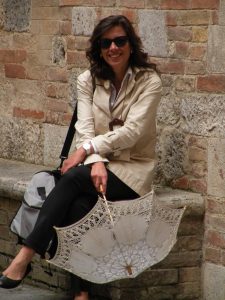 To celebrate the 700th anniversary of Dante’s death, My Flora Guide offers a series of dedicated guided tours: “Dante 700” walks, completely outdoors, through Dante’s places in Florence (Baptistery, Badia Fiorentina, Bargello, Società Dantesca, Torre della Castagna, Sasso di Dante, etc.), immersive visits to museums (Dante House-Museum, Bargello National Museum) and personalized visits.
To celebrate the 700th anniversary of Dante’s death, My Flora Guide offers a series of dedicated guided tours: “Dante 700” walks, completely outdoors, through Dante’s places in Florence (Baptistery, Badia Fiorentina, Bargello, Società Dantesca, Torre della Castagna, Sasso di Dante, etc.), immersive visits to museums (Dante House-Museum, Bargello National Museum) and personalized visits.
For additional information, please write to : info@myfloraguide.com




